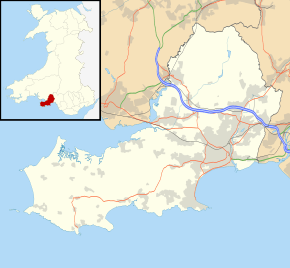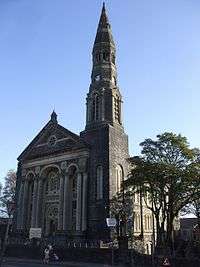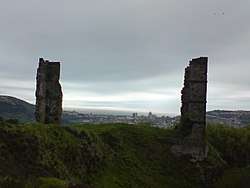Morriston
Morriston (/mɒrɪstʌn/; Welsh: Treforys [trɛ'fɔrɪs]) is a community in the City and County of Swansea, Wales and falls within the Morriston ward. It is the largest community in Swansea county.
Morriston
| |
|---|---|
 Morriston Location within Swansea | |
| Population | 16,928 (Ward 2011 census)[1] |
| OS grid reference | SS6698 |
| Principal area | |
| Ceremonial county | |
| Country | Wales |
| Sovereign state | United Kingdom |
| Post town | SWANSEA |
| Postcode district | SA6 |
| Dialling code | 01792 |
| Police | South Wales |
| Fire | Mid and West Wales |
| Ambulance | Welsh |
| UK Parliament | |
| Senedd Cymru – Welsh Parliament |
|
Morriston is sometimes referred to as a distinct town[2] (e.g. the local football club is named Morriston Town A.F.C.), however it has never had a town charter,[3] and is now part of the continuous urban sprawl around Swansea, the centre of which lies three miles to the south-west. It is the most populous of Swansea's electoral divisions and is situated close to other communities including Plasmarl, Treboeth, Llansamlet, Cwmrhydyceirw, Clase, Ynystawe and Ynysforgan.
Landscape and geography
Morriston is in the Lower Swansea Valley, adjoining the River Tawe, on terrain sloping gently downwards to the east and steeply upwards to the west. It is centred on Woodfield Street, a shopping area that runs in a north-south axis. The street features two of Morriston's most notable structures, the Church of St John and Tabernacle Chapel.
In its original design, St John, locally known as "Church in the Middle of the Road", was the centre piece of Morriston. It has fallen into disrepair and is no longer used as a church. Tabernacle Chapel is a Grade I listed building designed by architect John Humphrey and built between 1870 and 1872. Tabernacle has sometimes been called "the Cathedral of Welsh non-conformity".
The two buildings remain the town's main landmarks along with Morriston Hospital and the Driver and Vehicle Licensing Agency (DVLA), both major employers in the area. The hospital, the largest in Swansea, is located in Cwmrhydyceirw, about one mile north of Morriston town centre. The DVLA is in Clase, a suburb west of Morriston; it processes all British driver and vehicle registrations.
The remainder of Morriston can be divided into three areas:
- an area of early 19th century two-storey terraced houses around the main area of shops;
- areas further north, close to the M4 motorway, largely composed of semi-detached housing built from the 1940s to the 1960s;
- a mix of 19th-century and more recently built houses along Clydach Road in Ynystawe.[2]
Retail
The heart of the town retail community is at Woodfield Street, which consists of many small shops and pubs. Once a month the street is closed to traffic for Morriston Market, a monthly street market selling Welsh produce from hand-made items to fresh food. The nearby Swansea Enterprise Park comprises national chains.
Transport
Morriston was originally located next to the Swansea Canal, which, along with the River Tawe, was essential for the transport of goods in the Swansea Valley. The canal was superseded by rail and roads with Morriston now conveniently located just off Junction 45 of the M4 motorway and adjacent to the A4067.
The nearest railway stations are at Llansamlet and Swansea High Street. Until the 1960s, Morriston had two railway stations, Morriston East and Morriston West on the Morriston Branch of the Swansea District line and the Swansea Vale Railway. Both stations no longer exist. The Swansea District line is still in use, transporting freight traffic and also for the Fishguard to Cardiff/Cheltenham Spa passenger service. It runs through northern Morriston with a viaduct at Clydach Road.
The centre of Morriston contains a large car park and has bus routes from Morriston Hospital into Swansea City Centre and on to Swansea University with services provided by First (South & West Wales). The area has two taxi offices with a taxi lane in Woodfield Street.
Tabernacle Chapel

Tabernacle Chapel is the outstanding building in the centre of Morriston and visually dominates the area. It has been described as the "Non-Conformist Cathedral of Wales" while Anthony Jones, in his 1996 definitive book "Welsh Chapels" described the chapel as "The largest, grandest and most expensive chapel built in Wales".[4] The book features the iconic Grade 1-listed building as its cover-photograph.
Victorian industrialisation brought rapid population growth to the Lower Swansea Valley, close to the port of Swansea, as rural workers sought new employment opportunities in many tinplate and copper works established in the area. Welsh Nonconformity enjoyed great popularity; a dozen chapels were built in the Morriston area alone in the latter half of the 19th century and Tabernacle, planned as the ultimate evocation of a Welsh chapel in terms of architecture, space and facilities, was completed in 1872 at a staggering cost of £18,000. The design was evolved by three prominent figures in the area: the minister, Emlyn Jones, the architect, John Humphrey and the contractor Daniel Edwards. The Cambrian national newspaper described it as "the one great redeeming feature in that manufacturing district, an oasis in a desert".
Morriston Park
Sir John Morris, 1st Baronet of Clasemont, built a mansion in 1775 called Clasemont at Pengwern on the western slopes of the Lower Swansea valley. The mansion had a garden of extensive open grassland giving way to a wooded wilderness and panoramic vista. In 1911, Swansea Corporation purchased 47 acres of Clasemont which became Morriston Park in 1912. For several years the park received investment and new facilities, hosting many activities, carnivals and musical performances. It once incorporated a large ornate bandstand, swimming baths, lido, aviary, cricket pitch, changing rooms, shop and even a 9-hole golf course. But in recent years all of these assets, and more, have disappeared. Over the years the significance of Morriston Park has slipped from the collective consciousness. It now suffers from severe drainage problems with many paths and borders overgrown and in poor condition. Despite this neglect, the park still maintains the structure of an 18th century landscape garden with magnificent views over the Lower Swansea valley.
Industrial heritage
Morriston is part of the Lower Swansea Valley. Over a period of about 150 years up until the 1920s, the valley was one of the most heavily industrialised areas of the developed world. Morriston was constructed as "Wales' earliest planned industrial village" and was laid out on a grid pattern designed by William Edwards [5] and named after its founder, Sir John Morris, Bt. The grid pattern remains in evidence today. Morris originally named the town "Morris Town", but this was shortened into the single word "Morriston" with the Welsh language translation being Treforys.
Morriston was initially constructed for the workers of the tinplate and copper industries that built up along the banks of the River Tawe in the 18th century. The Swansea Canal also ran through the area transporting coal, limestone and other products along the valley but it was drained from Clydach to Swansea in the 1970s. Some small remains, including a footbridge, are still present in Morriston.
Tin-plating had almost vanished from the area by the end of the Second World War, with production in South West Wales concentrated at new works in Felindre and Port Talbot.[6][7]
Sir John Morris was also responsible for the construction between 1768 and 1774 of Morris Castle, considered to have been the world's first accommodation built specifically for workers by their employer. Little of the structure remains today, although its ruins are visible on high ground above the nearby Landore district.[8]
Arts
Morriston has two choirs. Morriston Orpheus Choir was formed in 1935 and performs around 25 engagements annually and undertakes performances on television and at national events.
Morriston RFC Male Choir was formed in 1979 by members of the local rugby club. It is one of the foremost Welsh choirs.
Sport
Morriston R.F.C. is a rugby club[9] founded in 1876 and based at Maes Collen. It is one of the founder clubs of the current Welsh Rugby Union and feeder club to the Ospreys region. The club caters for all age group rugby from age 6 to youth & senior sides and has produced many players who have achieved international honours including Ross Moriarty.
Morriston has several amateur association football clubs, most of which play in the Swansea Senior League: Morriston A.F.C. is a former Welsh Football League team based at The Dingle. Morriston Athletic, Morriston Olympic and C.R.C. Rangers are also based in Morriston. Games between Morriston Olympic and C.R.C (Cwmrhydyceirw) Rangers are fiercely contested, with scores of supporters lining the pitch at Tir Canol whenever the two sides meet.
Listed buildings
Grade I listed buildings:[10]
- Capel Tabernacl on Woodfield Street designed by Architect John Humphrey, whose story has been captured in the book The Remarkable Life of John Humphrey, Gods Own Architect by David Farmer (1997)
Grade II listed buildings:
- Former Annealing Building in George Cohen's Works, off Beaufort Road
- Morfydd Street Bridge & Boundary Wall to Davies Street
- Seion Chapel on Clase Road
- Philadelphia Chapel incl. attached Chapel House & Sunday School on Globe Street
- Former Police Station & House on Martin Street
- 'Danbert House' (former Employment Exchange) on Morfydd Street. Built in the 1880s for local industrialist Daniel Edwards (and named after his patent tinplate) it is now derelict.[11]
- War Memorial in Morriston Park
- Church of St. John on Woodfield Street
Notable residents
- William Richard Arnold, Welsh rugby union international
- Cliff Bowen, Wales rugby union international and Carmarthenshire cricketer
- Anthony Clement, Welsh rugby union international
- Stevie Davies, award-winning Welsh novelist
- Richard and Paul Moriarty Welsh rugby union internationals
- D.Z. Phillips, philosopher of religion
- James Thomas, former Swansea City A.F.C. and Welsh U21 football international
- Hayley Tullett, international athlete
- Shane Williams, Welsh rugby union international, 2008 IRB International Player of the Year, all-time leading try scorer for Wales
- Peter Hill, Bishop of Barking, London
References
- "Ward population 2011". Retrieved 13 April 2015.
- Morriston Ward Profile September 2008
- Archives Network Wales
- "History of the Tabernacle". Tabernacle, Morriston. Retrieved 10 March 2020.
- The Welsh Academy Encyclopedia of Wales. Cardiff: University of Wales Press 2008
- Introduction: Historical Background Archived 23 February 2007 at the Wayback Machine
- Morriston - Treboeth History Group Archived 23 February 2007 at the Wayback Machine
- "Data Wales: A note on a worker's castle in Swansea". Archived from the original on 26 August 2016. Retrieved 1 November 2008.
- Morriston R.F.C.
- City and County of Swansea - Listed Building Index Archived 9 August 2014 at the Wayback Machine
- Knapman, Joshua. "This historic house that looks like something from the Addams Family needs serious renovation". Wales Online.
External links
